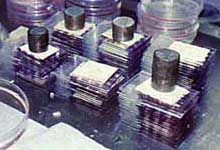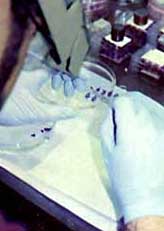![]()
Information on our Tissue Processing Procedures
 Tissue Processing: Tissue was embedded in celloidin (Parlodion, Fisher Scientific, P35-100, $497.43/100 g) by Dr. Glenn Rosen and colleagues at Beth Israel Deaconess Medical Center (BIDMC). Upon arrival at BIDMC, brains are placed in fresh 10% formalin for two weeks before embedding. After two weeks, the brains are washed in water for 24 hours before being dehydrated by being placed for 1 day each in a series of 80%, 95%, 100% ethanol and ethanol/ether solutions. The brains are placed into 3% celloidin (in ethanol/ether) for at least a week followed by 12% celloidin for 2–3 days. The celloidin block is trimmed to achieve a stable base;those brains to be cut in the coronal plane are notched over the left hemisphere, those to be cut in the horizontal plane on the left. Sections are cut on a sliding microtome at 30 µm and are segregated into 10 compartmented plastic boxes (Cat. #6636, $8.40, Brain Research Laboratories, brainlab@aol.com, 1–617–965–5544). These boxes have 6x6 compartments each, of which only 5x6 were used. Three brains were cut into a single box—each brain occupying two successive rows. Each compartment therefore contained a 1-in-10 series of sections.
Tissue Processing: Tissue was embedded in celloidin (Parlodion, Fisher Scientific, P35-100, $497.43/100 g) by Dr. Glenn Rosen and colleagues at Beth Israel Deaconess Medical Center (BIDMC). Upon arrival at BIDMC, brains are placed in fresh 10% formalin for two weeks before embedding. After two weeks, the brains are washed in water for 24 hours before being dehydrated by being placed for 1 day each in a series of 80%, 95%, 100% ethanol and ethanol/ether solutions. The brains are placed into 3% celloidin (in ethanol/ether) for at least a week followed by 12% celloidin for 2–3 days. The celloidin block is trimmed to achieve a stable base;those brains to be cut in the coronal plane are notched over the left hemisphere, those to be cut in the horizontal plane on the left. Sections are cut on a sliding microtome at 30 µm and are segregated into 10 compartmented plastic boxes (Cat. #6636, $8.40, Brain Research Laboratories, brainlab@aol.com, 1–617–965–5544). These boxes have 6x6 compartments each, of which only 5x6 were used. Three brains were cut into a single box—each brain occupying two successive rows. Each compartment therefore contained a 1-in-10 series of sections.
 Sections from one compartment are then transferred as a group to one compartment of a circular net for staining. This circular net is a clear plastic cylinder divided into six (Cat. #6115, $33.75, Brain Research Laboratories) or eight (Cat. #8115, $41.20) compartments with a fine plastic mesh bottom and an open top. Every fifth section is stained for Nissl substance with cresyl violet (CV: cresylech violett, Cat No. 1A396, $222/10 g vial, Cellpoint Science, Divison of Roboz, 1–800–999–9734). This procedure entails washing sections in distilled water and then placing them in 0.5% CV solution for 3–5 minutes. Each section is placed in distilled water for 1 minute and then differentiated and dehydrated in 80 and 95% ethanol. A few drops of colophonium (Rosin: Sigma, R-3755) are added to the 95% ethanol baths. If differentiation is adequate the sections are then cleared with terpineol (Fisher, T31) and passed through xylol.
Sections from one compartment are then transferred as a group to one compartment of a circular net for staining. This circular net is a clear plastic cylinder divided into six (Cat. #6115, $33.75, Brain Research Laboratories) or eight (Cat. #8115, $41.20) compartments with a fine plastic mesh bottom and an open top. Every fifth section is stained for Nissl substance with cresyl violet (CV: cresylech violett, Cat No. 1A396, $222/10 g vial, Cellpoint Science, Divison of Roboz, 1–800–999–9734). This procedure entails washing sections in distilled water and then placing them in 0.5% CV solution for 3–5 minutes. Each section is placed in distilled water for 1 minute and then differentiated and dehydrated in 80 and 95% ethanol. A few drops of colophonium (Rosin: Sigma, R-3755) are added to the 95% ethanol baths. If differentiation is adequate the sections are then cleared with terpineol (Fisher, T31) and passed through xylol.
 Every 10th section was mounted in Permount (Fisher, SP-15) on a 3x2 inch slide (Fisher, Clay Adams) and coverslipped (Fisher, Clay Adams Gold Seal 48x60 mm, 1 oz; Cat. No. 3334). Sections are mounted with careful attention to orientation so that left and right are consistently identifiable. Coronal series were mounted as if the observer were viewing the brain from the front—with the animal’s left hemisphere on the right side of the slide. Horizontal sections were mounted as if the observer is viewing the brain from the dorsal surface—the animal’s left hemisphere on the left side of the slide. Weights were applied to the slide for a week or more to express excess Permount and to ensure that the sections were pressed flat. Slides were carefully cleaned about three weeks after coverslipping.
Every 10th section was mounted in Permount (Fisher, SP-15) on a 3x2 inch slide (Fisher, Clay Adams) and coverslipped (Fisher, Clay Adams Gold Seal 48x60 mm, 1 oz; Cat. No. 3334). Sections are mounted with careful attention to orientation so that left and right are consistently identifiable. Coronal series were mounted as if the observer were viewing the brain from the front—with the animal’s left hemisphere on the right side of the slide. Horizontal sections were mounted as if the observer is viewing the brain from the dorsal surface—the animal’s left hemisphere on the left side of the slide. Weights were applied to the slide for a week or more to express excess Permount and to ensure that the sections were pressed flat. Slides were carefully cleaned about three weeks after coverslipping.
Last updated July 31, 2000, Alex and Rob Williams and Glenn Rosen. Initiated April 12, 1999.